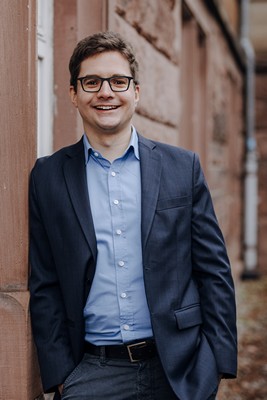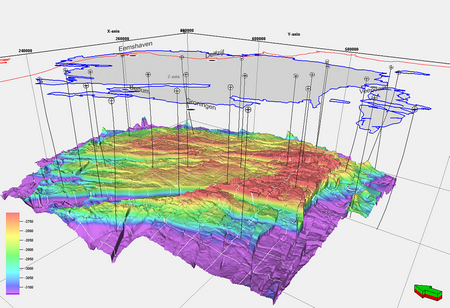De bodem onder Groningen biedt ook kansen

Iedereen weet inmiddels van de bodemdaling en aardbevingen die de gaswinning in de provincie Groningen veroorzaakt. Maar hoe dat precies gebeurt, is ingewikkeld. Adjunct-hoogleraar geo-energie Johannes Miocic bestudeert het gesteente waaruit het gas wordt gewonnen. Dit moet meer inzicht bieden in wat er nog gaat gebeuren in de gasvelden, en in hoe we beter gebruik kunnen maken van dat gesteente. Waterstof opslaan in lege gasvelden lijkt bijvoorbeeld een optie.
Johannes Miocic studeerde geologie en aardwetenschappen in Duitsland, waar hij onder meer zandsteen uit Nederlandse offshore gasvelden bestudeerde. Hij promoveerde aan de Schotse universiteit van Edingburgh op een proefschrift over opslag van kooldioxide. Bijna een jaar geleden kwam hij bij de RUG werken. Zijn onderzoek is gefinancierd door DeepNL, een onderzoeksprogramma van NWO dat is opgezet om het ‘fundamentele begrip te verbeteren van de dynamiek van de diepe ondergrond onder invloed van menselijk ingrijpen’.

Bodemdaling
Miocic: ‘Mijn interesse ligt bij processen in zandsteen. De zandsteen die ik in Duitsland bestudeerde, was van hetzelfde type als die in het Slochteren-gasveld, legt hij uit. ‘Ik wil weten hoe de samenstelling van deze steensoort varieert binnen een gasveld en tussen verschillende velden.’ Hij kijkt daarbij vooral naar de mineralen die in zandsteen zijn afgezet: die bepalen de mechanische eigenschappen en de grootte van de poriën in de steenlaag. Meer kennis over dit zandsteen maakt een betere voorspelling mogelijk van de bodemdaling in en rond de gasvelden.
‘Bodemdaling ontstaat doordat gaswinning de druk verlaagt. Hierdoor zal uit de omringende gebieden water naar het gasveld stromen, waardoor ook daar bodemdaling kan optreden. Die zal niet zo dramatisch zijn als in het gasveld, maar het is wel een proces dat tientallen jaren kan doorgaan.’ Miocic zal gesteente onderzoeken uit de boorkernen van ruim vierhonderd gaswinningsputten die de NAM de afgelopen zestig jaar heeft geslagen. ‘We maken daarvoor dunne plakjes van ongeveer dertig micrometer om te bepalen welke mineralen erin zitten.’ Dit gebeurt vooral op het oog, maar Miocic en zijn promovendi zullen ook technieken gebruiken als elektronenmicroscopie en röntgendiffractie.

Oude woestijn
Op basis van dit detailonderzoek van gesteente uit gasputten moet hij de geologie van een heel gasveld afleiden. ‘Dat wordt een uitdaging. We zullen onze gegevens daarvoor combineren met bestaande 3D-modellen van de geologie.’ Sedimentologie speelt een belangrijke rol bij het achterhalen van de manier waarop het gesteente is gevormd. Het zandsteen ontstond in een oude woestijn. ‘Ten noorden van Groningen lagen ooit grote zoutmeren, iets ten zuiden waren bergen. Die bergen erodeerden en het materiaal is naar het noorden getransporteerd door rivieren die door een vlakte stroomden. Dus we moeten uitzoeken welk gesteente waar vandaan komt.’
Naast de samenstelling wil Miocic ook de sterkte van het gesteente onderzoeken. Dit gebeurt in een geologisch lab van de Universiteit Utrecht. De resultaten combineert hij met die van andere, meer theoretische onderzoeken uit het DeepNL programma. ‘Dat zou ons een beter beeld moeten geven van wat er precies in de Groningse bodem gebeurt.’
Injecteren
Aangezien de daling van druk de oorzaak is van veel problemen, is er voorgesteld om gas of water in de lege velden te injecteren. ‘Het is theoretisch mogelijk de lege velden te gebruiken om opgevangen kooldioxide op te slaan’, zegt Miocic. ‘Maar vermoedelijk zullen de inwoners van het gebied dat geen goed idee vinden. Bovendien vormen de ruim vierhonderd winningsputten evenzovele plekken van mogelijke lekkage. En CO2 kan het cement aantasten waarmee oude putten zijn dichtgemaakt.’ Het injecteren van water is veiliger, maar de hoeveelheid water die nodig is om de druk weer op peil te brengen is niet realistisch.
Lege gasvelden kunnen niettemin nuttig zijn, bijvoorbeeld voor de opslag van waterstof. ‘Dat is een beetje een hype, maar het is wel degelijk een goede manier om energie op te slaan waarmee je de dalen in de productie van groene stroom uit zon en wind kunt opvangen.’ Waterstof is veilig op te slaan in gasvelden of zoutmijnen. ‘In het zuidoosten van Groningen is zout gewonnen, daar zijn geschikte zoutcavernes. De Gasunie werkt daar momenteel aan een faciliteit voor waterstofopslag.’ Maar Miocic kent tot nu toe maar een stuk of vier voorbeelden in de wereld van zo’n opslag.

Micro-organismen
Wel is er een lastig probleem met waterstofopslag – al zou het ook een kans kunnen zijn: ‘Micro-organismen in de bodem eten waterstof, ze gebruiken het als energiebron.’ Dit zorgt voor verlies tijdens de opslag, en kan zorgen voor verstopping van de poriën in het zandsteen, waar door de waterstof niet meer is op te pompen. Maar micro-organismen kunnen waterstof ook met kooldioxide combineren tot methaan. ‘Je zou dus een put kunnen injecteren met vloeibare waterstof en kooldioxide. Die vloeistoffen migreren naar een tweede, nabijgelegen put en worden onderweg omgezet in methaan dat je kunt terugwinnen. In Oostenrijk is een veldtest aan de gang om te zien of dat in de praktijk werkt.’
Bodemwarmte winnen
Naast een beter begrip van lege gasvelden en nieuwe manieren om ze te gebruiken heeft Miocic nóg een idee voor de bodem onder Groningen: het winnen van bodemwarmte. ‘Dat gebeurt traditioneel door twee diepe boorgaten te verbinden en dan water naar beneden en weer omhoog te pompen. Maar voor de verwarming van huizen is het voldoende om ondiepe putten van zo’n honderd meter te boren en daarin een U-vormige pijp te plaatsen waar je water doorheen pompt.’ Het combineren van dit warme water met een warmtepomp is een efficiënte manier om huizen te verwarmen. ‘Het werkt beter dan warmtepompen die de warmte uit de lucht halen,’ aldus Miocic.
In Duitsland heeft hij al eens een inventarisatie gemaakt van waar dit mogelijk is. ‘Een masterstudent zal hetzelfde doen voor Groningen. Je hebt wel goed geïsoleerde huizen nodig en ruimte voor een boorgat. Dat moet volgens de regels bovendien een paar meter van de bebouwing liggen.’ Miocic is onlangs een project begonnen met het Centrum voor Informatietechnologie (CIT) van de RUG, waarin de mogelijkheden hiervoor worden geïnventariseerd in heel Nederland. Dat gebeurt op basis van informatie over het type huis, de beschikbare ruimte en de ondergrond.

New Energy Coalition
Alles bij elkaar is er voldoende werk voor een geoloog in Groningen. ‘Mijn doel is een geo-energiegroep op te bouwen van vijf tot tien personen om al deze thema’s op te pakken.’ De groep is onderdeel van het Energy and Sustainability Research Institute Groningen (ESRIG). ‘De samenwerking binnen dit instituut is prima. En we zitten ook vlak bij de New Energy Coalition, die ons verbindt aan verschillende bedrijven. Wij kunnen het onderzoek leveren dat zij nodig hebben.’
Meer nieuws
-
06 januari 2026
AI-phasie: kunstmatige intelligentie helpt bij taalgebrek

